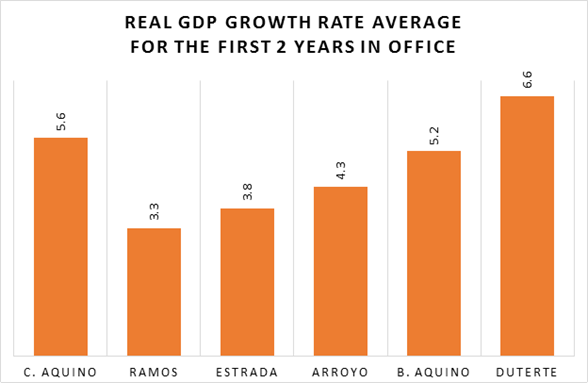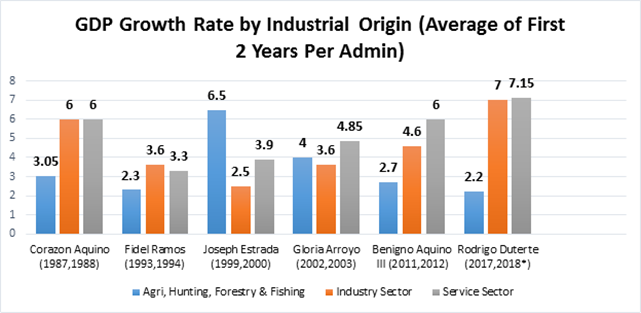The first two full years of the administration of President Rodrigo Duterte registered the highest level of economic growth among post-Marcos administrations, averaging 6.6 percent for the years 2017 and 2018.
The Philippine’s real Gross Domestic Product (GDP) grew by 6.7 percent in 2017 and is projected to have grown by at least 6.5 percent in 2018. This projection is based on the revised target of 6.5 to 6.9 percent growth rate for 2018, as the actual growth rate for the fourth quarter has yet to be released (see Table 1).
In comparison, the Aquino III administration posted an average of 5.2 percent for 2011-2012. Previous administrations meanwhile averaged 4.3 percent, 3.8 percent, 3.3 percent, and 5.6 percent under Arroyo, Estrada, Ramos, and Corazon Aquino, respectively.
“The country’s growth is domestic-driven as we invest heavily in our infrastructure through the ‘Build, Build, Build’ program, and we also do the same for our human capital,” Department of Budget and Management Secretary Benjamin Diokno said.
In terms of real GDP growth by industrial origin, the data shows that growth is becoming more investment-driven under President Duterte. In his first two years in office, the growth of the industry sector even outpaced overall GDP growth, with the industry sector growing at an average of 7 percent (see Table 2).
“This is crucial for the Philippine economy to achieve its poverty-reduction goals,” Diokno said. The industry sector is a potential source of high-paying jobs. This will allow those from the rural sector to lift their families out of poverty, the Budget Chief explained.
Meanwhile, Diokno also recognized that the administration needs to improve its performance in the agricultural sector. Historical data shows that it has the potential to grow at 4 percent and beyond, as demonstrated by the Estrada and Arroyo administrations.
“If we are able to grow agriculture by 4 percent, the economic growth target of 7 to 8 percent is very much attainable. This administration intends to work on its weakest link to realize the fullest potential of our sectors, and further drive growth for the people,” Diokno said.
Table 1

Note: Lower end of the revised growth target of 6.5% to 6.9% for 2018 (6.5%) was used as actual data for the fourth quarter has yet to be released.
Table 2

(30)
PR No. 2019-13
For inquiries, further questions and requests for interview, please contact Marianne Ongjuco:
Email:Telephone: (+632)-735-4847

